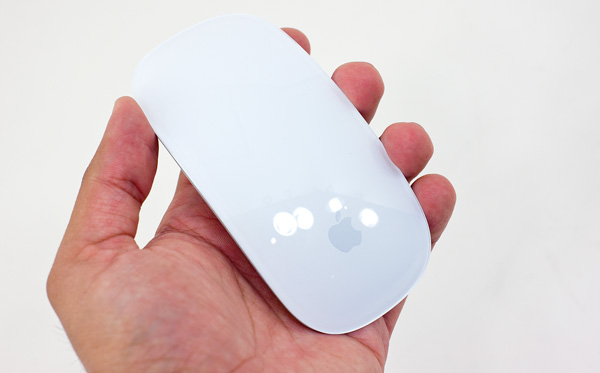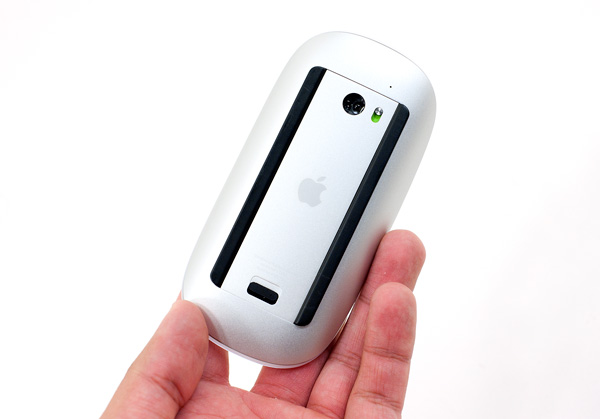Apple Mac Pro (Mid 2010) Review
by Anand Lal Shimpi on October 6, 2010 9:26 PM ESTInput Devices
The Mac Pro ships with two input devices by default: the Apple USB keyboard with numeric keypad, and the Magic Mouse.
The keyboard I'm a huge fan of. If you're ok with the relatively condensed design, it's great to type on. The angle feels just right, there's good feedback from the keys and even the key travel seems just right. The biggest issue is that it isn't an ergonomic design in the style of the Microsoft Natural keyboards.
You get a row of helpful function keys along the top and two USB ports integrated into the keyboard itself. The ports are only good for delivering 100mA of power so you'll have to look elsewhere to charge your iPhone/iPod.
I've used the keyboard before, it's actually what I do most of my writing on. I'd say there's still tons of room for improvement in the comfort department so I'd like to see Apple go back to the drawing board with its now 3-year old design. The mouse however, I'd never had any real experience with.
The Mighty Mouse was Apple's first attempt at a two-button mouse with a modern Mac. By using a touch sensor in the mouse itself you could push on the right side of the mouse to simulate a right click. A nifty way of adding a right mouse button without actually capitulating to the demands of the radical two buttoners.
The successor to the Mighty Mouse is named the Magic Mouse. Stylistically the Magic Mouse is probably the best looking mouse I've ever used. It looks great on a desk. Even the on/off switch underneath is well designed. It also takes touch to the next level. Instead of using a touch sensor to simply determine left from right clicks, you can now gesture on the surface of the mouse.
The supported gestures include scrolling (both horizontally and vertically) and two finger swipe to flip through photos or web pages.
The scrolling gestures are nice. I found myself getting excited whenever I’d have a window open that I needed to scroll in. It’s just so much more effortless than using a scrollwheel, even the newer low-friction wheels. But at the end of the day I just couldn't get over the ergonomics of the mouse. Matthew Witheiler, the first AnandTech Senior GPU Editor, swears by his but I couldn't get used to it. The Magic Mouse is extremely low profile and doesn't really contour to my hand at all. I suppose it's ok for occasional mousing but I simply point too often.
The Magic Mouse also lacks the smooth tracking feel that most Microsoft and Logitech mice have. There are two plastic strips that run along the base of the mouse, serving as feet. They are solid plastic with no soft coating at all. If you use your mouse on a desk without a mousepad it feels like you're scraping the mouse across the desk rather than smoothly gliding it across. Even on a mousepad the feel isn't great.
If you like the idea of going all the way with touch on a desktop there’s also the optional Magic Trackpad. This one doesn’t come with the Mac Pro but it is a $69 option. And as its name implies, it’s a giant trackpad.
I was a lot happier with the Magic Trackpad than I was with the Magic Mouse. The gestures are easier to do and you get more of them. By far the most useful was sliding four fingers up or down on the trackpad to trigger different Exposé modes. Scrolling is also nice and smooth and the trackpad surface is arguably too big, I don’t use most of it but it’s nice to have.
My biggest issue with the Magic Trackpad is its positioning on my desk. Trackpads work on notebooks because they’re situated directly in front of your keyboard. Move your right hand down for tracking and back up for typing. On a desk the trackpad is physically a lot further away from your hands. You can position it in front of your keyboard but then it interferes with typing since the trackpad doesn’t lay flat on your desk.
You could argue that the trackpad is the same distance away from your hands as a traditional mouse, but I believe one of the benefits of a trackpad is its closer-than-a-mouse location. You lose that advantage with the Magic Trackpad.
Other than that it boils down to personal preference. While I have no problems using a trackpad on a notebook, at my desk I still use a mouse. The trackpad is nice for gestures but it’s not good for gaming and I find that I’m slower with it for precision movements than a mouse.
Both the Magic Trackpad and Magic Mouse are Bluetooth devices that rely on two AA batteries. The pairing process is simple under OS X, although it’s worth mentioning that you’ll have no mouse support until you do install Apple’s drivers under Boot Camp. That means you’ll have to go through the Windows install process without a mouse.
Assuming linear battery drain based on our testing we estimate around 6 months of battery life on the Magic Trackpad. I haven’t used the Magic Mouse enough to give you an equivalent estimate.
On the 2009 Mac Pro I noticed an issue with Bluetooth reception and the Magic Trackpad where I’d occasionally get a stuttery mouse cursor. Users have tracked this down to an issue with the Bluetooth antenna in the system not being sensitive enough. In my testing of the 2010 Mac Pro I haven’t been able to duplicate the problem but that’s not to say it’s gone entirely. It’s just that so far things have been fine.















84 Comments
View All Comments
Macdesign - Thursday, November 4, 2010 - link
The motherboard of the 2006 is only 32bit and only the processor is 64bit. The 2008 and 2009 Models are full 64bit on both motherboard and processor so W7 can run on them.standar29 - Thursday, November 18, 2010 - link
Seems like people want to consider the other aspects of business costs so we might as well add in the fact that VOLUME DISCOUNTS on hardware weren't mentioned in this article and probably more than take care of all of these additional costs. Apple's profit margin is well known.Chuck_Darwin - Monday, January 31, 2011 - link
Anand, before I bought my Mac Pro last fall I priced an equivalent system on Newegg. I was reluctant to rely on any manufacturer after 10 years of building my own. I found Newegg's prices to be within $300 of Apple, except for one thing: you really can't buy an equivalent case at Newegg. That $249 Antec you used to compare isn't even close to the same class as Apple's. You can find one on Amazon, though, and it runs around $400. Similarly, the Dell uses shoddy parts, like the case, to hit that price point. Wish you would've posted every component you used to compare so we can judge for ourselves.Conniesimmons - Wednesday, November 2, 2011 - link
Thanks for the comparison. I have a MAc Pro 2,1 dual quad core 3 GHz with a new 480 SSD boot up drive in my optical bay, 4 750 TB internal drives, and 16 Ggs of memory. I am an editor using HD footage, but I don't do a lot of 3-D work. I keep looking at the new 12 core machines, but based on your review it still seems like I wouldn't see a really huge difference in FCP, compression programs, that would justify buying a new machine now instead of later. Any other improvements you might suggest?Do you have a consulting business?
Best, Connie